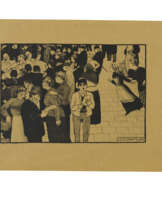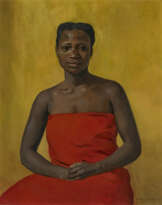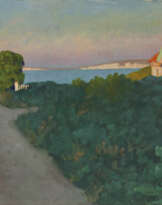ID 1051708
Lot 125 | Félix Vallotton (1865-1925)
Estimate value
€ 100 000 – 150 000
Le Tournesol
signé et daté ‘F. VALLOTTON. 24’ (en bas à gauche)
huile sur toile
81.3 x 65.2 cm.
Peint en 1924
signed and dated 'F. VALLOTTON. 24' (lower left)
oil on canvas
32 x 25 5⁄8 in.
Painted in 1924
Provenance
Atelier de l’artiste.
Galerie Paul Vallotton, Lausanne.
Anne-Marie Chapuis, Lausanne (en 1963).
Collection particulière, Versoix.
Galerie Vallotton, Lausanne (en 1994).
Sam Josefowitz, Pully (acquis auprès de celle-ci le 8 juillet 1994).
Puis par descendance aux propriétaires actuels.
Literature
F. Vallotton, Livre de raison, no. LRZ 1513 reproduit in Ausstellung Félix Vallotton, cat. exp. Kunsthaus, Zurich, 1938, p. 95 (titré 'Nat[ure] morte, un soleil. dans un bocal de verre vert accompagné de deux fleurs pendantes rouge fond Jouy violet. (T 25)').
V.-E. Photiadès, 'Lettre de Suisse, Une visite à Lausanne à la rétrospective Vallotton' in Comœdia, 22 septembre 1927, No. 5373, p. 3.
M. Ducrey, Félix Vallotton, L'Œuvre peint, Catalogue raisonné, Seconde partie, 1910-1925, Milan, 2005, vol. III, p. 837-838, no. 1610 (illustré en couleurs).
Exhibited
Bâle, Kunsthalle, René Auberjonois, Albert Kohler, Alexander Soldenhoff, Félix Vallotton, mai 1926, p. 11, no. 186 (titré 'Nature morte soleil').
Lausanne, Musée Arlaud et Bern, Kunsthalle, Félix Vallotton, septembre-novembre 1927, no. 82.
Zurich, Kunsthaus, Félix Vallotton, janvier-février 1928, p. 23, no. 171 (titré 'Die Sonnenblume').
Winterthour, Kunstmuseum, Neue Sachlichkeit und Surrealismus in der Schweiz, 1915-1940, septembre-novembre 1979, p. 9, no. 307.
Lausanne, Galerie Paul Vallotton, Un ensemble d'huile de Maîtres suisses et français, du XIXe et du XXe siècle, décembre 1979-janvier 1980, no. 38 (illustré en couleurs, titré 'Nature morte au soleil').
Lausanne, Galerie Vallotton, Exposition de printemps, Peintures et dessins, avril-mai 1994, no. 9.
Further details
L'on retrouve plusieurs types de natures mortes sous le pinceau de Felix Vallotton: des représentations presque ascétiques, complètement dépouillées, et a contrario des déluges baroques de fleurs et d’objets, envahissant l’espace.
Il y a cependant peu de toiles qui allient ces deux extrêmes de la même façon que Le Tournesol, peint en 1924. Il n’y a dans cette toile finalement que deux sortes de fleurs, dans un vase uni, au centre de l’œuvre, ce qui dénote avec certaines des compositions de l’artiste, où peuvent surgir pêle-mêles livres, fruits, tableaux ou tout autres objets. Ici, le mur et le socle, tapissés de toile de Jouy violette, se mélangent dans un foisonnement de dessins sur fond violet, un décor fou, floutant les limites d’espaces et de volumes, laissant l’impression que le vase est suspendu dans les airs au milieu de la toile.
De ce vase jaillissent deux variétés de fleurs que l’artiste, féru de symbolique, n’a pas associé par hasard. Dans le langage floral, le tournesol est un symbole d’amour et de fidélité, car il accompagne le soleil du matin au soir. Cette fleur peut aussi pousser sur n’importe quel sol – du moment que le soleil la regarde. Le tournesol, que Vallotton renomme «soleil» dans son Livre de Raison, n’apparaît d’ailleurs que dans deux autres de ses natures mortes, qui ont toutes les deux la même toile de Jouy violette en fond. De son côté, l’amarante est un symbole d’immortalité, son nom en grec signifiant «qui ne se flétrit point» Pourtant, les amarantes chutent vers le sol, où deux pétales du tournesol sont déjà tombés. Il ne serait pas étonnant que Vallotton se soit amusé dans cette toile à déjouer les symboliques, étant lui-même en 1924 à l’automne de sa vie.
Félix Vallotton produced several types of still life: some almost ascetic representations, completely stripped bare, and, in contrast, a number of baroque deluges of flowers and objects, which completely take over the space.
Few paintings, however, combine these two extremes in the same way as Le Tournesol, painted in 1924. In this painting, there are only two kinds of flowers in a single vase in the centre of the work, in contrast to some of the artist's other still-life compositions, in which books, fruit, paintings and other objects might be brought together. Here, the wall and the foreground, covered in violet toile de Jouy, blend together in a profusion of motifs on a violet background, a wild décor that blurs the boundaries of space and volume, leaving the impression that the vase is suspended in mid-air in the middle of the painting.
From this vase spring two varieties of flowers that the artist, a lover of symbolism, did not bring together by chance. In the language of flowers, the sunflower is a symbol of love and fidelity, as it accompanies the sun from morning to night. This flower can also grow on any kind of soil - as long as the sun shines upon it. The sunflower, which Vallotton refers to as the 'sun' in his Livre de Raison, only appears in two other of his still lifes, both of which have the same violet toile de Jouy in the background. Amaranth, meanwhile, is a symbol of immortality, its name in Greek meaning 'that which does not wither'. The amaranths, however, are drooping towards the floor, where two petals of the sunflower have already fallen. It is not surprising that Vallotton should have played with symbolism in this painting, as he himself was in the autumn of his life in 1924.
| Artist: | Félix Vallotton (1865 - 1925) |
|---|---|
| Applied technique: | Oil on canvas |
| Genre: | Still life |
| Auction house category: | Paintings |
| Artist: | Félix Vallotton (1865 - 1925) |
|---|---|
| Applied technique: | Oil on canvas |
| Genre: | Still life |
| Auction house category: | Paintings |
| Address of auction |
CHRISTIE'S 9 Avenue Matignon 75008 Paris France | ||||||||||||||
|---|---|---|---|---|---|---|---|---|---|---|---|---|---|---|---|
| Preview |
| ||||||||||||||
| Phone | +33 (0)1 40 76 85 85 | ||||||||||||||
| Fax | +33 (0)1 40 76 85 86 | ||||||||||||||
| Conditions of purchase | Conditions of purchase | ||||||||||||||
| Shipping |
Postal service Courier service pickup by yourself | ||||||||||||||
| Payment methods |
Wire Transfer | ||||||||||||||
| Business hours | Business hours
|














